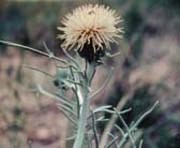
The vegetation of Sleeping Bear Dunes National Lakeshore is as varied as is the habitat and weather of the park. Plants growing in the sandy dunes and beaches have adaptations for surviving the extremes of hot, dry conditions, wind and blowing sand. Plants such as sea rocket have succulent leaves to hold moisture. Bearberry has tough, leathery leaves to reduce evaporation. Pitcher's thistle leaves have a velvety surface to reduce desiccation by the wind and spend several years developing a deep root system before they flower, set seed and die. Dune grass has deep roots to reach water. The story of the plants in the park is a story of adaptation for survival. Flowers of the forest floor develop leaves early in the season to gather sunlight before the trees leaf out overhead. The flowers of maples and other trees bloom early to take advantage of the wind for pollination before the leaves develop. The deciduous trees in the forest survive the dry winter conditions by dropping their leaves altogether. This loss of leaves also prevents accumulation of the heavy snows of this snow belt region that could break their branches. The hard leaf surface and resins of coniferous trees protects them from winter freezing and drying. The lacy structure of pine needles, or in the case of cedars and firs, their conical shape, helps to shed snow. All of the plants have a growth advantage in the maritime climate due to the nearness of Lake Michigan. The waters of Lake Michigan, warmed by the summer sun, moderate the weather and lengthen the growing season. The large body of water keeps the air cooler in summer, warmer in winter, and wetter throughout the year. The moist air contributes to the heavy snows that can blanket the ground in winter.
Check out NPSpecies for a Sleeping Bear Dunes plants and animals list.
South Manitou Island The vegetation of South Manitou Island (5,000 acres) is probably representative of the vegetation of Michigan's northwest lower peninsula before impacts of farming and deer browsing. The forests are heavy in beech and maple, but also have impressive stands of champion size, uncut northern white cedar. The ground cover is thick with yew, which cannot thrive in the presence of deer browsing. Perhaps the richest examples in Michigan of spring flowers exist on the island with several species of trillium, Jack-in-the-pulpit, hepatica, trout lily, spring beauty, and bloodroot. There are twelve species of orchids on the island. The dunes themselves are alive in brightly colored flowers such as the dune lily, harebell, hoary puccoon, and wind anemone and flowers of more subtle colors such as Pitcher's thistle, false heather and death camas. It can be surprising to find plants on the dunes that are associated with more wet environments such as northern white cedar, wild grape, red-osier dogwood, and equisetum. North Manitou Island The vegetation of North Manitou Island (15,000 acres) is remarkably different from that of South Manitou Island due to nearly 80 years of browsing by an introduced deer herd that reached populations exceeding 2000 animals. There are no deer on South Manitou Island. A number of studies have been conducted to document the vegetative differences between the 2 islands and to tract the vegetative changes that are occurring as the deer herd has been reduced to fewer than 100 animals through a very successful hunting program. |
Last updated: December 6, 2023
